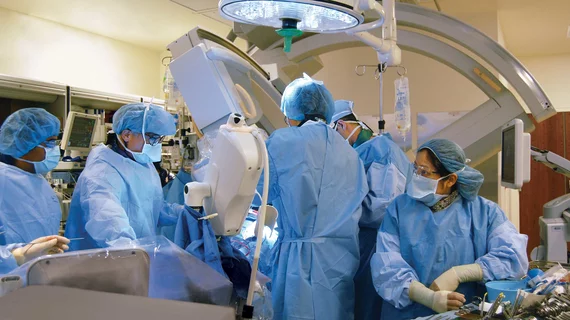Temporary pacemakers after TAVR could reduce need for permanent implants
Using temporary pacemakers to address early conduction disturbances following transcatheter aortic valve replacement (TAVR) may reduce the number of patients who require a permanent pacemaker (PPM) after treatment, according to an observational study published in eClinicalMedicine.[1]
The research was first presented to the public at EuroPCR 2024 in Paris.
“Despite the rapid adoption of TAVR, there is a lack of prospective trials investigating the optimal management of patients with conduction disturbances after TAVR,” wrote first author Sanshuai Chang, MD, a valvular heart disease specialist with Beijing AnZhen Hospital, and colleagues. “The guidelines for cardiac pacing recommend different time thresholds for PPM implantation, ranging from 48 hours to seven days after TAVR. The current clinical pathway on the management of conduction disturbances after TAVR primarily relies on expert opinion. Accordingly, the lack of clinical evidence and effective strategies has resulted in extensive variations in PPM implantation patterns, potentially leading to over-early or unnecessary PPM implantation.”
Chang et al. explored data from 688 TAVR patients treated at one of 13 hospitals in China from March 2022 to March 2023. Seventy of those patients developed high-degree atrioventricular block (HAVB), complete heart block (CHB) or first-degree atrioventricular block plus new-onset left bundle branch block during or within one of month the procedure. The mean patient age was 74 years old, and nearly 59% were men.
After one month, the authors determined that 76% of patients who received a temporary pacemaker did not require a PPM. Overall, that means just 17 of 688 TAVR patients treated during that time required a PPM, good for a 30-day rate of just 2.4%.
After six months, HAVB/CHB recurrence was not seen in any patients who received a temporary pacemaker, but not a PPM. Among patients who did receive a PPM, meanwhile, 15 had a high ventricular pacing rate (VPR) and the other two had intermittent HAVB with a much lower VPR.
From a safety perspective, the group added, no adverse events occurred during implantation of the temporary pacemaker. However, one patient “pulled out the lead due to discomfort” and had to undergo PPM implantation.
Reviewing these findings, the group did find that using temporary pacemakers “as a bridge” showed potential to help keep PPM implant rates down among TAVR patients. They noted, however, that their research had certain limitations, including its limited follow-up period and the “advanced age” of the patient population. In addition, most patients included in this trial received a self-expanding TAVR valve, making it unclear what the outcomes may be in patients with a balloon-expandable valve.
“The use of a temporary-permanent pacemaker has advantages in the management of conduction disturbances after TAVR,” the group wrote. “The active fixation lead offers a retractable helix with extraordinary flexibility and an extended scope for regular monitoring and pulse generator interrogation. Vascular access to the internal jugular or subclavian veins enables rapid ambulation after the procedure without increasing hospitalization length while ensuring greater patient comfort and mobility; patients undergoing temporary-permanent pacemaker implantation can be discharged early to resume normal daily activities.”
Click here to read the full analysis.

